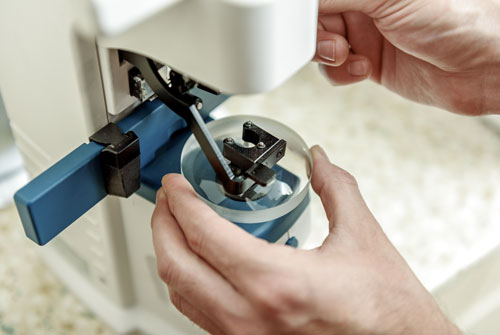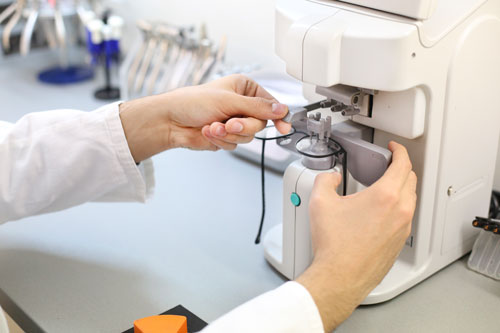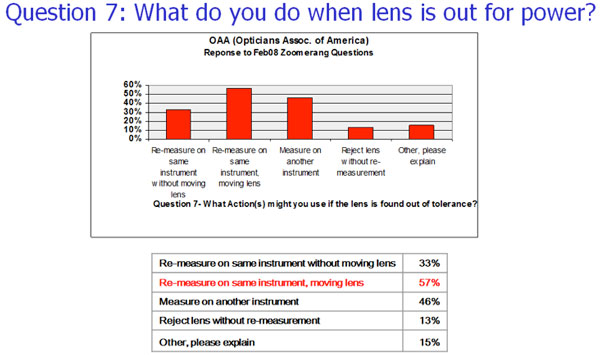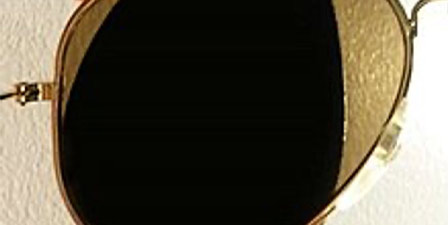In preparation for the 2020 revision to ANSI Z80.1, the committee has been reviewing topics relevant to the revision and seeking input. One area identified is Focimetry, where many questions are commonly asked. At the March 2017 ANSI Meeting (and subsequent Vision Council Lens Technical committee), a document I drafted was reviewed for accuracy of content. The following Focimetry related topics and responses were reviewed by both committees, and represent a consensus of opinion on the topics raised. Given the length of this document, it has been broken up into two parts.

 Focimeters – Manual vs. Automated (pros and cons related to inspection)
Focimeters – Manual vs. Automated (pros and cons related to inspection)
Standard focimeters used to inspect through power of spectacle lenses have been the primary tool for inspection since their introduction close to 100 years ago. Until the late 1970s, these manual visual focus devices were the primary instruments used to measure lens power. The “manual” instruments relied on visual judgment to determine best focus when judging power.
Over the past three decades, electronic instruments have gained in popularity. With these machines the operator no longer sees image quality as the focus or reading of the lens power is done electronically. While many “electronic” or automated units have the ability to read out digitally to 0.01, this does not mean this is also their accuracy capability. In reality, both devices have similar limitations with regard to accuracy, but each has merit when considering their use for lens inspection. The fact that automated electronic units can display to increased resolution does not translate to increased accuracy. The purpose of this section is to provide insight on pros and cons for both types when inspecting lenses.
Accuracy vs. Precision of readout
There is confusion over the comparative accuracy of manual focus vs. automated readout electronic devices. It is common for electronic devices to have readouts that display readings to 0.01. For some, this ability means there must be a greater accuracy to such devices over the manual devices. Digital readouts that display to 0.01 does help by eliminating the interpretation of the reading on the manual power drum. However, it does not mean the units are otherwise more accurate. Focimeters with the traditional ~6mm diameter aperture and large span of measurement (+/- 20 Diopters) have limitations which make affordably priced units incapable of meeting 0.01 D accuracy.
 Standard focimeter accuracy
Standard focimeter accuracy
When powers are measured in the range of +/-5 D, it is generally accepted that errors of up to 0.06 D may be expected for standard low cost focimeters. This accuracy has not changed significantly over the decades, and is not likely to be improved upon unless higher cost devices are used, which is not likely for typical laboratory operations.
Since this 0.06 error is ½ the standard power tolerance, it is also recognized that measuring lenses of marginal power can be challenging. This situation leads to uncertainty when accepting /rejecting product to ANSI Z80.1 Standards.
Judging compliance
When a lens measures off power, but is within 0.03-0.05 of the target power with the applied tolerance, questions arise as to what the best practice might be given the uncertainty of power measurement from such devices. Certainly, instrument calibration should be monitored to assure the device used to judge compliance is operating to specifications.
A common practice when examining borderline power lenses is to re-measure the lens. This can be done on the same device, or other units as a means to make an educated judgment. Slight movement of the measurement point is also common practice when re-measurement is done. ANSI Z80 polled 331 Opticians in 2008 and found the following common practices when the lens is found to be off power.

In part 2 of this series, the following topics relative to Focimetry will be discussed:
- Handling rounding modes when inspecting to Power tolerances
- Visual detection and focimeter Aberration
- Monitoring Calibration/ instrument drift
- Why are the tolerances for Plano lenses different in ANSI Z87.1 than for ANSI Z80.1?












